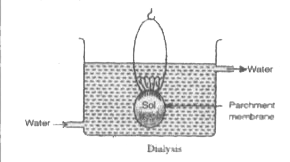Explain the following: (i) Gold number (ii) Dialysis.
(i) Gold number. The different protecting colloids differ in their protecting powers. Zsigmondy introduced a term called gold number to describe the protective power of different colloids. This is defined as the number of the milligrams of the protective colloid required to just prevent the coagulation of a given gold sol when I ml of a 10% solution of sodium chloride is added to it. The coagulation of gold sol is indicated by change in the colour from red to blue. For example, gold number of egg albumin is 0.08 and that of starch is 25. It may be noted that smaller the value of the gold number greater will be protecting power of the protective colloid. For example, out of albumin and starch, starch, has less protecting power than albumin.

(ii) Dialysis. The method used to separate the impurities from the colloidal solution is called dialysis. Its principle is based upon the fact that colloidal particles cannot pass through a parchment of cellophane membrane while the ions of the electrolyte can pass through it. The colloidal solution is taken in a bag made of cellophane or parchment. The bag is suspended in fresh water. The impurities slowly diffuse out of the bag leaving behind pure colloidal solution. Dialysis can be used for removing HCl from the ferric hydroxide sol.
Topper's Solved these Questions
- SURFACE CHEMISTRYBook:MBD -HARYANA BOARDChapter:SURFACE CHEMISTRYExercise:LONG ANSWER TYPE QUESTIONS
Explore 4 Videos
- SURFACE CHEMISTRYBook:MBD -HARYANA BOARDChapter:SURFACE CHEMISTRYExercise:LONG ANSWER TYPE QUESTIONS
Explore 4 Videos
- SOLUTIONSBook:MBD -HARYANA BOARDChapter:SOLUTIONSExercise:LATQ ( LONG ANSWER TYPE QUESTIONS )
Explore 25 Videos
- THE D- AND F- BLOCK ELEMENTSBook:MBD -HARYANA BOARDChapter:THE D- AND F- BLOCK ELEMENTSExercise:LONG ANSWER TYPE QUESTIONS
Explore 8 Videos
Similar Questions
Explain the following:
Gold number
View SolutionExplain the following : (i) mass number , (ii) atomic number and (iii) isotopes .
View SolutionExplain the following:
(i) Smoke (ii) Fumes (iii) Dust (iv) Mist
View SolutionExplain the following :
(i) Gold and silver are mixed to make ornaments.
(ii) Sodium is preserved in kerosene.
View SolutionExplain the following
(i) F - centres
(ii)Doping .
View SolutionExplain the following terms:
(i) Peptization (ii) dialysis (iii) Hardy-Schulze ruel
View SolutionExplain the following terms:
(i) Peptization (ii) dialysis (iii) Hardy-Schulze rule
View SolutionExplain the following terms:
Dialysis
View SolutionWrite on the following:
(i) The Gold Rush
(ii) Position of natives in Australia
View SolutionExplain the following:
(i) Vaccination (ii) Autoimmune diseases.
View Solution
